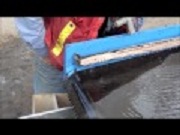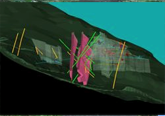Engineer Mine, B.C. Geological Overview
Native gold is the principle metallic mineral at Engineer Mine. The Engineer Mine is noted for museum class gold and electrum specimens and is a type locality for the mineral allemontite (stibarsen and native arsenic). Gold grades at the Engineer Mine are sporadic, ranging from trace to 50 grams per tonne gold.
Quartz veining and gold mineralization occurs in two modes at the Engineer Mine property, in brittle deformation and hydrothermal breccia zones along Shear Zone “A” and along structures outside of the Shear Zone “A” deformation zone.
Shear Zone "A"
Shear Zone “A” is a northwest-trending 200 metre-wide shear zone with a protracted deformation history, related as a splay to the major terrane-bounding Llewellyn fault. Earliest semi-ductile deformation along Shear Zone “A” may be as old as Late Triassic. Shear Zone “A” was reactivated along its northern boundary in the Eocene. The reactivation coincides with the emplacement of a volcanic complex immediately to the southeast at Engineer Mountain; part of the Sloko Group. Hydrothermal fluids related to the Sloko Group volcanic complex were focused along Shear Zone “A” and other pre-existing fractures on the property, resulting in gold-bearing hydrothermal veins and breccias.
Brittle Deformation and Hydrothermal Breccia Zones
The first mode of gold mineralization at the Engineer Mine property, occurring in brittle deformation and hydrothermal breccias zones along the Shear Zone “A” deformation zone, represents a bulk tonnage gold target. This gold occurs in quartz-calcite-pyrite cemented hydrothermal breccias and quartz vein zones 50 metres along a strike length of more than 250 metres. The lateral and depth extents have not been tested. The breccia zone is focused along the north side of Shear Zone “A”, in the Eocene reactivated domain. Several breccia types are recognized in core, including pyrite cemented polymict breccias, fine pale quartz-cemented breccias, dark siliceous breccias with varying clast content, and intrusive clast breccias. Overprinting, multi-stage quartz-pyrite veining relationships are also recorded in core. Gold values are highest in zones of fine quartz flooding, and high silver values are attributed to quartz-arsenopyrite-stibnite veins.
High-Grade Gold and Silver Veins
The second mode of mineralization at the Engineer Mine property is in high-grade gold and silver veins that occur outside of the Shear Zone “A” deformation zone. These quartz-calcite veins formed in pre-existing structures that were re-opened during the Eocene hydrothermal event and reactivation of Shear Zone “A”. To the south of Shear Zone “A”, the veins are both extensional and shear in character. They show a structural relationship to Shear Zone “A” movement. Historic production in the area was from the Engineer and Double Decker veins (view Summary Map) that extend south from the reactivated section of Shear Zone “A”. These veins are less than 2 metres wide, strike northeast, and pinch and swell along strike but have good vertical continuity.
Other important gold veins that occur outside of the Shear Zone “A” deformation zone are the high-grade Shaft vein and the Boulder-Governor vein system; all are to the north of Shear Zone “A”. The Shaft vein is vertical on surface but changes to moderately southwest-dipping at depth. It produces coarse free gold. A high-grade zone on the Shaft vein, 113 metres below surface on the 5 Level underground, has bands of arsenopyrite and stibnite up to 1 centimetre wide. The mineralogy is similar to the very high grade Engineer vein to the south. The nearby Bolder-Governor vein system produces free gold in quartz and carbonate concentrated in hydrothermal breccia zones up to 5 metres wide and 50 metres long at vein intersections. The veins strike northwest and southeast. Bonanza gold grades were mined in the 1990’s at these vein intersections.
Host Rocks
The host rock to all the veins and breccia zones on the Engineer Mine property is argillite and greywacke of the Laberge Group. Monzodiorite dykes related to the Sloko Group complex occur across the property, displaying varying degrees of quartz-carbonate-clay alteration. Some of the most altered dykes may be rhyolite dykes from the same intrusive event.
THE ENGINEER MINE, TAGISH LAKE, BRITISH COLUMBIA
Mark H. F. Mauthner, Lee A. Groat and Mati Raudsepp
Department of Geological Sciences University of British Columbia
The Mineralogical Record, volume 27, July-August, 1996
(Read the Report)



